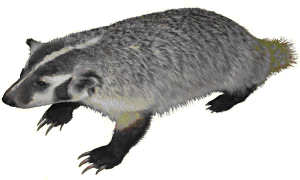 CENTENNIAL MUSEUM-CHIHUAHUAN DESERT GARDENS—THE UNIVERSITY OF TEXAS AT EL PASO
CENTENNIAL MUSEUM-CHIHUAHUAN DESERT GARDENS—THE UNIVERSITY OF TEXAS AT EL PASO
Tejón
Centennial Museum Collection
Scientific name: Taxidea taxus
Classification
Kingdom: Animalia
Phylum: Chordata
Class: Mammalia
Order: Carnivora
Family: Mustelidae
Genus: Taxidea
Description
Badgers are nocturnal. They have a broad flat body, short tuff for a tail, centered white facial stripe lined on each side in black on small head and short legs with heavy, clawed feet.
Dorsal surface is covered with thick brown-grey fur, but legs and circles around the eyes are black and belly is creamy or white. Weight about 25 pounds; length about 30 inches. Scent
glands give off offensive odors.
Distribution
Western and central United States, southern Canada, and northern Mexico.
Home
North American Badgers are solitary; den is a grass-lined nest in an underground chamber at the end of a long tunnel.
Diet
Rodents, small mammals, frogs, lizards, snakes, worms, insects and their larvae, and fruit, and roots. They excavate much of their food.
Breeding
Gives birth to an average number of four babies in late April to mid-May. Mother brings food to her babies until they are two- thirds grown.
Defense
Sharp teeth and strong claws make this mammal a formidable foe. Its thick hair and loose skin provides protection, and it can run backwards as fast as forwards.
Desert Diary: Mammals/Mutualism?
By Arthur H. Harris, PhD, Director
Laboratory for Environmental Biology
The University of Texas at El Paso
People and dogs have joined together to hunt for thousands of years. Such a relationship between different species that benefits both is called mutualism. According to some, a different kind of dog—a coyote—teams up in such a relationship with a badger. The coyote's keen sense of smell and the badger's unrivaled ability as a digger are viewed as ready-made for partnership. According to this belief, the coyote locates inhabited rodent burrows, and the badger moves in to do the heavy earth moving, with the pair sharing the bounty. Others are more skeptical, believing that the cunning coyote has learned that trailing along behind a badger may reap rich rewards. As a badger roots out its hapless prey, a window of opportunity may open for the coyote—to snatch away dinner. Thus there may actually be two victims—the rodent who loses its life and the badger who loses a meal. Mutualism? Or thievery?
